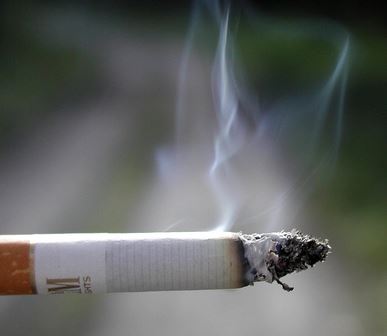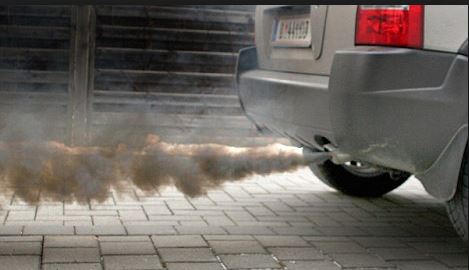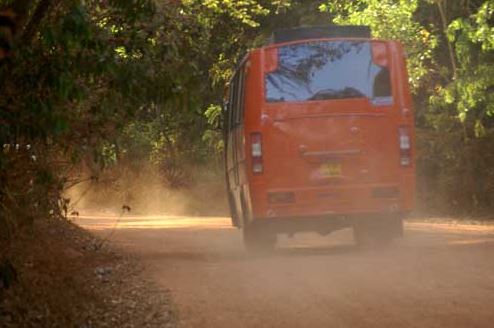| Components |
|---|
| Pollution |
| Soil conservation |
| Assessments |
Pollution is the introduction of wastes or harmful substances into the environment, making the environment unfit for supporting life in a healthy way.
The materials that cause pollution are called pollutants.
The components of the environment that can be polluted include air, water, and soil.
Polluting the air is called air pollution.
Air is a very important component of the environment since it supports life.
Fresh air is one of the most important natural resources that are necessary to support life.
How can air get polluted? Air can be polluted by smoke, gases, and dust.
This can happen in the following ways:
Video on air pollution
Smoke can get to the air from:


Gases get to the air from:
These are usually found in tightly closed containers. The gases are kept under pressure in these containers. They include perfumes, insecticides, some pesticides and some paints. These gases may cause respiratory diseases.

When vehicles run, they use up petrol or diesel and release gases into the air. Some of these gases are carbon dioxide and carbon monoxide which pollute the air. Some vehicles also use leaded fuel (fuel containing lead). These vehicles release lead in gas form in the air. Lead is very poisonous and when inhaled may cause damage to the brain.

Pesticides, herbicides and even some fertilizers contain chemicals that get carried into the air when a farmer is using them. These chemicals may be harmful can pollute the air just as aerosol sprays do.
Industries emit a lot of gas as waste products in the manufacturing process. Some of these gases may be carbon dioxide, carbon monoxide, lead, mercury, etc. These gases are poisonous to living things.
Ways in which dust can get into the air include:
activities that are carried out in quarries, for example blowing up rocks, emit a lot of dust in the air.
They move on murram roads, they raise a lot of dust in the air.
When wind blows, it raises dust into the air causing air pollution.

Air pollution may also cause water pollution.
This happens when polluted air containing various chemicals from the gases emitted by industries, vehicle exhausts, aerosol sprays and farm chemicals get into contact with rain water.
The chemicals in the polluted air dissolve in the rain water.
Some chemicals are acidic and when they dissolve in the rainwater, they make it acidic hence forming acid rain.
Standard 8
1. The table below shows four families and the source of energy they use for cooking.
|
Name of family |
Source of energy |
|
KUFO |
Biogas and charcoal |
|
BOMA |
Biogas and hydro-electricity |
|
KENI |
Solar and hydro-electricity |
|
MUTISO |
Firewood and solar |
The two families whose cooling methods have the worst effect on the environment are
A. KUFO AND KENI
B. MUTISO AND BOMA
C. KENI AND BIMA
D. MUTISO AND KUFO
2. A group of pupils studied how some pollutants affected water, air and soil. They recorded their results as shown in the table below.
‘Yes’ means pollutes.
‘No’ means does not pollute.
|
Pollutant |
Water |
Air |
Soil |
|
Farm chemicals Sewage Smoke from factories Water from factories |
Yes Yes No No |
No No Yes No |
Yes No No Yes
|
Which one of the following statements is true according to the information in the table?
A. Each pollutant pollutes both water and air
B. Water pollutants always pollute soil
C. Water and soil pollutants did not pollute air
D. Air and soil put together have more pollutants than water
3. Which one of the following methods of disposing of waste materials would have the worst effect on the environment?
A. Burying broken glass in the ground
B. Burning sawdust from sawmills
C. Throwing wood ashes onto the shamba
D. Throwing used oil into the bush
4. Which one of the following LEAST pollutes the environment when used for cooking?
A. Cow dung B. Kerosene C. Biogas D. Charcoal
5. Which one of the following practices do NOT pollute the environment?
A. Spilling used oil in a forest away from homes.
B. Spraying some oil on a lake to kill mosquito larvae
C. Dumping vegetable remains in a farm near homes
D. Duping factory wastes into a river that flows into the sea
6. Which one of the following materials would pollute the environment the LEAST when used as fuel?
A. Wood B. Kerosene C. Cow-dung D. Biogas
7. Which one of the following materials is NOT an air pollutant?
A. Noise B. Vehicle exhaust gases
C. Industrial fumes D. Decomposing vegetable matter
8. Which one of the following DOES NOT lead to destruction of the environment?
A. Poaching in game reserve
B. Keeping a large number of livestock on a small piece of land
C. Dumping vegetable wastes in the garden
D. Planting eucalyptus trees in swamps
9. The correct way to get rid of used plastic containers from the environment is to
A. Bury in the soil B. Throw in the river C. Burn D. Recycle